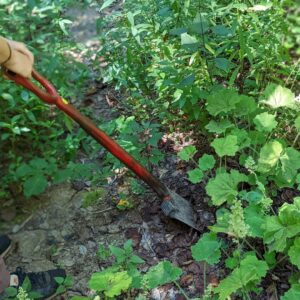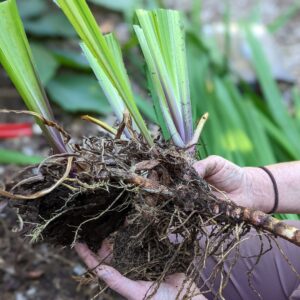It is Sunday morning, and I just finished watering the containers and the vegetable seedlings in my garden. The rest of the garden is not watered, as most are filled with well-established, native plants which will ride out the drought. This summer has been challenging, with high temperatures for weeks and very little rain. Fall will be a reprieve for both plants and humans as we look forward to cooler weather, and hopefully, more rain.
Cooler temperatures and the expectation of rain are some of the conditions where we need to propagate perennials by division. Dividing plants has been practiced for centuries by gardeners and farmers in many cultures and locations. It is a way to encourage good healthy growth by providing more space to spread out. Have you seen a large clump of Iris or Daylily with the center of the clump dead? This is due to overcrowding. The second reason we divide is to multiply our garden plants without waiting for seeds, a very frugal way to garden and to share our passion with our friends.
Dividing perennials is just as the name connotes — digging up the plant and splitting either by hand or by garden tool so that each piece has roots and tops. These divisions will quickly grow and establish in the garden.
Recently, I (JE) had the opportunity to talk with Mallory Smyth, Tyler Arboretum Senior Gardener (MS). She cares for many of our displays, from the Fruit Vault Steps to the Native Woodland Walk. Visitors can see her creative and masterful work everywhere.
Here’s our interview on dividing perennials in the fall:
JE: Why is the fall a good time to dig and divide perennials in the Northeast? How is this part of the Frugal Garden concept?
MS: Fall is a great time to dig and divide perennials for numerous reasons. The weather is cooling down, so plants are less likely to undergo as much shock as they would during the summer (*). During the fall, the plants are beginning to send their energy down to their root systems to prepare for their annual dormancy. This gives newly divided plants some time to develop some new roots and prepare for winter. Dividing perennials is a great way to rejuvenate a plant and make more to enhance your garden with more plants and share with friends, family, or the community.
(*) Plants lose water through their leaves at a higher rate during warm weather. When roots are cut during dividing, the plants need to conserve moisture, and the cooler conditions would allow them to do so.
JE: How do you know which perennials would do well with this method? What are some of the characteristics?
MS: Most plants with spreading and clumping root systems respond very well to dividing. These include plants like asters, daylilies, and grasses. In addition, some plants have modified roots called rhizomes, like irises, that can be divided relatively easily as well. Some plants I’ve divided with success in the Native Woodland Walk and other areas throughout the Arboretum include Hairy alumroot, Heuchera villosa ‘Autumn Bride;’ Foamflower, Tiarella cordifolia; Cup plant, Silphium perfoliatum; and Stonecrop, Sedum rupestre ‘Angelina’. This fall, I will be dividing some phlox, hosta, monarda, and Amsonia. They will be used to enhance their current locations, and add to new planting areas.
Several years ago, some Amsonia near the parking lot was planted too close to a walkway and now requires cutting back throughout the season. This fall, we will dig it up and transplant some further back into the bed, and divide and transplant the remainder in the Wister Rhododendron Garden. This will save money, as this particular Amsonia hubrichtii was initially planned to be purchased (for the latter).
JE: Which type of perennial will not respond to dividing?
MS: Plants with a taproot, or woody growth, do not respond well and should be propagated by seed or cuttings. An example of these would be milkweeds and lavenders.
JE: What other ways can gardeners make more plants and do it in the fall?
MS: Fall is the time to plant bulbs for spring blooms. Brent & Becky’s has a great selection, but check out your favorite independent garden center as well. I also love to take cuttings to start new plants. This is particularly important if you don’t want to disturb an existing population. Fall is the ideal time to grow Phlox subulata (moss phlox) from cuttings. I hope to grow this special native plant from our Pink Hill Serpentine Barrens in the Gravel Garden here at Tyler.
Do you have perennials that are large and need space to grow? Do you want to have more of that pink monarda (beebalm) next to the big bluestem? Dividing perennials will be key to your success.








